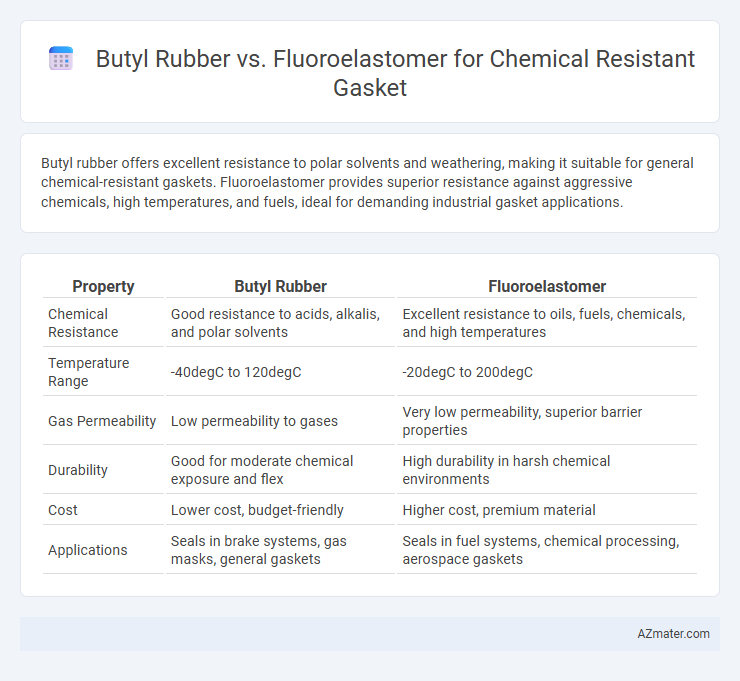Butyl rubber offers excellent resistance to polar solvents and weathering, making it suitable for general chemical-resistant gaskets. Fluoroelastomer provides superior resistance against aggressive chemicals, high temperatures, and fuels, ideal for demanding industrial gasket applications.
Table of Comparison
| Property | Butyl Rubber | Fluoroelastomer |
|---|---|---|
| Chemical Resistance | Good resistance to acids, alkalis, and polar solvents | Excellent resistance to oils, fuels, chemicals, and high temperatures |
| Temperature Range | -40degC to 120degC | -20degC to 200degC |
| Gas Permeability | Low permeability to gases | Very low permeability, superior barrier properties |
| Durability | Good for moderate chemical exposure and flex | High durability in harsh chemical environments |
| Cost | Lower cost, budget-friendly | Higher cost, premium material |
| Applications | Seals in brake systems, gas masks, general gaskets | Seals in fuel systems, chemical processing, aerospace gaskets |
Introduction to Chemical Resistant Gaskets
Chemical resistant gaskets are critical components in industrial applications, ensuring leak-proof seals in environments exposed to harsh chemicals. Butyl rubber is known for its excellent resistance to polar chemicals, acids, and alkalis, making it suitable for moderate chemical exposure. Fluoroelastomers exhibit superior resistance to a wide range of aggressive chemicals, high temperatures, and solvents, making them ideal for demanding applications requiring long-term durability.
Overview of Butyl Rubber Properties
Butyl rubber exhibits excellent resistance to gases, moisture, and many chemicals, making it suitable for chemical-resistant gaskets in various industrial applications. Its low permeability and strong resilience provide effective sealing performance under moderate temperature and pressure conditions. However, butyl rubber may have limited resistance to oils and solvents compared to fluoroelastomers, which offer superior chemical and thermal stability.
Overview of Fluoroelastomer Properties
Fluoroelastomers exhibit exceptional chemical resistance, maintaining integrity in aggressive environments involving fuels, oils, solvents, and acids, significantly outperforming butyl rubber in these conditions. Their high-temperature tolerance, typically operating effectively from -40degC up to 200degC, makes them ideal for demanding gasket applications requiring durability and stability. The superior resistance of fluoroelastomers to swelling, compression set, and degradation under harsh chemical exposure ensures longer service life and reliability compared to butyl rubber gaskets.
Chemical Resistance Comparison
Butyl rubber exhibits excellent resistance to polar solvents, acids, and alkalis but performs poorly against oils, fuels, and hydrocarbons, limiting its chemical resistance scope for gasket applications. Fluoroelastomers offer superior chemical resistance across a broad spectrum, including exposure to oils, fuels, hydrocarbons, and aggressive chemicals, making them ideal for demanding environments. The choice between butyl and fluoroelastomer gaskets hinges on the specific chemical exposure, with fluoroelastomers providing enhanced durability in highly aggressive chemical conditions.
Temperature Performance Differences
Butyl rubber typically withstands temperatures ranging from -40degC to 120degC, making it suitable for applications with moderate thermal requirements. Fluoroelastomers, such as Viton, offer superior temperature resistance, maintaining performance from -26degC up to 204degC, ideal for high-temperature chemical environments. The enhanced thermal stability of fluoroelastomers ensures gasket integrity under prolonged exposure to elevated temperatures and aggressive chemicals, outperforming butyl rubber in demanding industrial conditions.
Physical and Mechanical Properties
Butyl rubber offers excellent impermeability to gases and moderate resistance to chemicals, with high flexibility and good tensile strength, making it suitable for sealing applications requiring elasticity. Fluoroelastomers exhibit superior chemical resistance against fuels, oils, and aggressive solvents, maintain mechanical integrity at high temperatures, and show outstanding compression set resistance, ideal for harsh chemical environments. The choice between butyl rubber and fluoroelastomer depends on required thermal stability, chemical exposure, and mechanical durability in gasket applications.
Cost and Availability
Butyl rubber offers a lower cost and greater availability compared to fluoroelastomers, making it a popular choice for chemical-resistant gaskets in budget-sensitive applications. Fluoroelastomers provide superior chemical resistance and thermal stability but come with a higher price tag and limited supplier options. Selecting between the two materials depends on balancing budget constraints with the required chemical exposure durability.
Typical Applications in Industry
Butyl rubber gaskets are widely used in pharmaceutical, food, and beverage industries due to their excellent resistance to water, steam, and polar solvents, ensuring reliable sealing in sanitary processes. Fluoroelastomer gaskets excel in chemical processing, automotive, and aerospace sectors by providing superior resistance against hydrocarbons, oils, fuels, and aggressive acids, making them ideal for environments exposed to harsh chemicals. Industrial applications demand selecting Butyl rubber for non-aggressive media and Fluoroelastomer for high-temperature, chemically intensive conditions to optimize gasket performance and longevity.
Installation and Maintenance Considerations
Butyl rubber offers flexibility and ease of installation due to its excellent compression set resistance, making it suitable for gaskets that require frequent removal and reinstallation. Fluoroelastomer, while more chemically resistant to aggressive solvents and high temperatures, demands careful installation with compatible lubricants to prevent damage and ensure longevity. Maintenance for butyl rubber gaskets typically involves routine inspection for ozone and UV degradation, whereas fluoroelastomer gaskets require monitoring for chemical swell and hardening to maintain optimal sealing performance.
Choosing the Right Material for Your Gasket Needs
Choosing the right gasket material depends on the specific chemical environment and temperature range of your application. Butyl rubber offers excellent resistance to acids, alkalis, and polar solvents, making it suitable for low to moderate temperature chemical sealing. Fluoroelastomers excel in high-temperature environments and resist a broad spectrum of aggressive chemicals, including hydrocarbons, making them ideal for harsh industrial applications requiring durability and chemical stability.

Infographic: Butyl rubber vs Fluoroelastomer for Chemical resistant gasket
 azmater.com
azmater.com